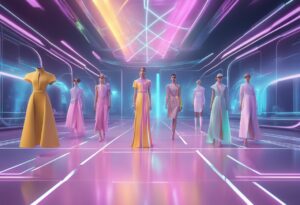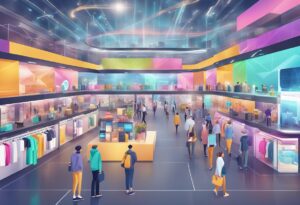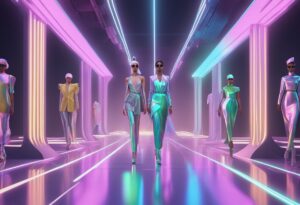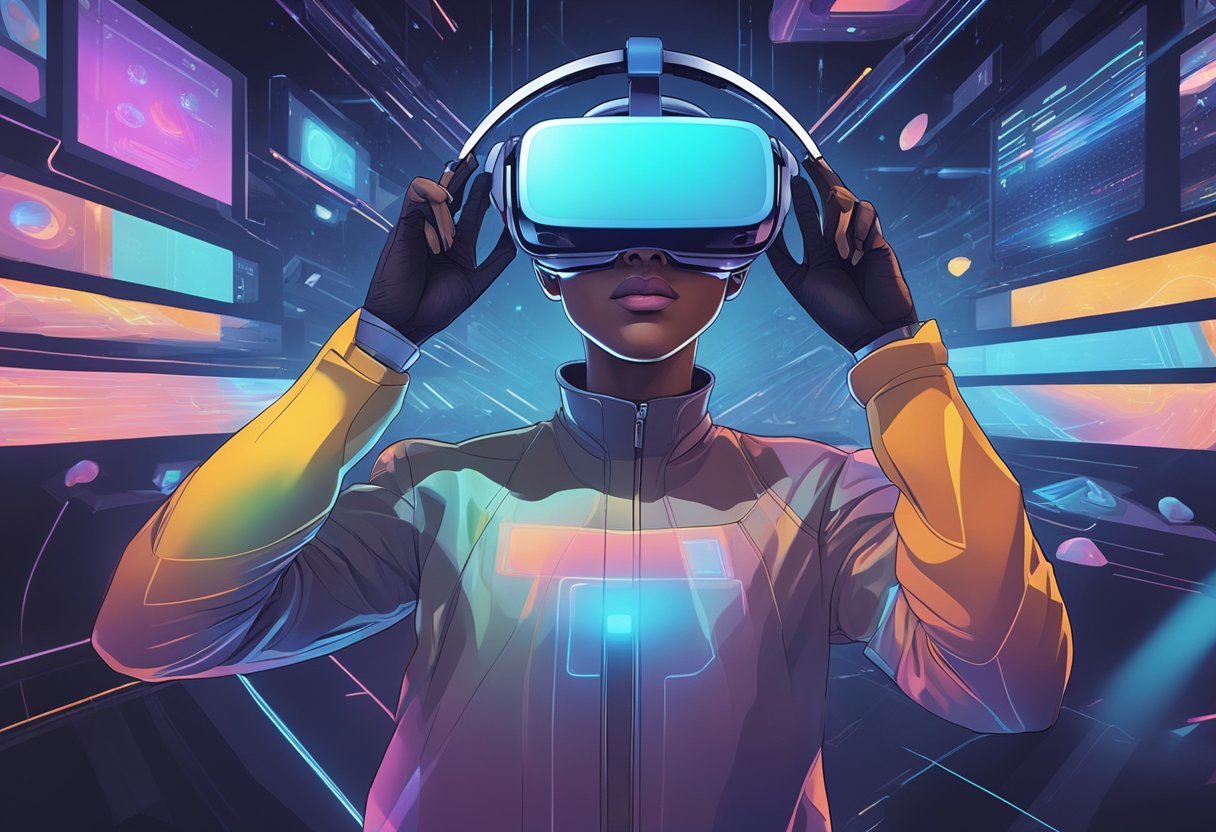The fashion industry has always been at the forefront of innovation, and the emergence of the metaverse is no exception. The metaverse, a term used to describe a virtual world that is accessible to anyone with an internet connection, has the potential to revolutionize the way we interact with fashion. As technology continues to advance, the fashion industry is exploring new ways to incorporate the metaverse into their business models.
The metaverse is a natural fit for the fashion industry, as it allows for endless possibilities in terms of design and creativity. In the metaverse, fashion is not limited by physical constraints, which means that designers can create garments that would be impossible to produce in the real world. The metaverse provides an opportunity for fashion brands to connect with consumers in new and innovative ways. For example, virtual fashion shows and digital clothing try-ons are just a few ways that fashion brands are using the metaverse to engage with customers.
As the metaverse continues to evolve, it is clear that it will play an increasingly important role in the future of fashion. From virtual fashion shows to digital clothing, the possibilities are endless. As technology continues to advance, it will be interesting to see how the fashion industry continues to embrace the metaverse and all that it has to offer.
The Evolution of Fashion in the Metaverse
The fashion industry has always been at the forefront of adopting new technologies, and the metaverse is no exception. The metaverse, a virtual world that is accessible to anyone with an internet connection, has transformed the way people interact with each other and with digital content.
The fashion industry has embraced this new technology, and it has become an integral part of the industry’s digital transformation.
The Rise of Virtual Fashion and Avatars
The metaverse has given rise to a new form of fashion: virtual fashion. Virtual fashion refers to clothing and accessories that exist only in the digital world. Avatars, digital representations of people, have become the perfect canvas for virtual fashion.
Designers can create clothing and accessories that would be impossible in the physical world, and users can express themselves in new and exciting ways.
How Metaverse Used in Fashion
The metaverse has become a platform for fashion designers to showcase their collections in a new and innovative way. Designers can create virtual runways, where users can watch models walk down the catwalk in real-time. Users can also try on virtual clothing and accessories, which can be purchased in the real world. The metaverse has also given rise to new business models, such as non-fungible tokens (NFTs), which allow designers to sell unique and limited-edition virtual items.
The metaverse has transformed the fashion industry by giving rise to virtual fashion and avatars. The metaverse has become a platform for fashion designers to showcase their collections in a new and innovative way, and it has given rise to new business models.
The fashion industry’s adoption of the metaverse is a testament to the industry’s willingness to embrace new technologies and to continue to evolve and innovate.
What to wear in the Metaverse
1. Custom Avatars
In the metaverse, your avatar is your digital persona, and customizing it to reflect your personal style is key. Just like in real life, what you wear can express your identity, mood, and affiliations. Custom avatars can be outfitted with a variety of clothing items, from casual wear to formal attire, depending on the setting and your personal preference. Brands in the metaverse offer a range of styles, allowing for a high degree of personalization.
You can choose from existing designs or commission bespoke items to stand out. The freedom of the metaverse means you can also experiment with fantastical elements like wings, glowing garments, or even shape-shifting outfits that change with your environment.
2. Branded Apparel
Wearing branded apparel in the metaverse is a way to connect with your favorite fashion labels and showcase your loyalty to them. Many well-known brands have created digital collections that can be purchased for avatars. This includes everything from luxury brands like Gucci and Balenciaga to sportswear giants like Nike and Adidas.
These items often mirror their real-world counterparts, allowing users to extend their physical fashion tastes into the digital realm. Wearing branded apparel can signify status and taste within the metaverse, much like in the physical world.
3. Exclusive Digital Drops
Exclusive digital drops, or limited edition releases, are highly sought after in the metaverse. These can be one-of-a-kind pieces or part of a limited run, creating a sense of exclusivity and community among those who manage to acquire them. Often, these items are sold as NFTs, providing proof of ownership and the potential for resale value to increase over time. Exclusive drops can range from avant-garde designer outfits to special collaboration pieces between artists and brands, giving wearers a unique edge in their digital appearance.
4. Virtual Accessories
Accessories in the metaverse can elevate your avatar’s look and add a layer of complexity to your digital style. These can include hats, jewelry, glasses, bags, and even virtual pets.
Accessories might carry special meanings, represent achievements within a game or platform, or simply be aesthetic choices. Some accessories are interactive or have animated features, such as a hovering backpack or a necklace with a glowing pendant, adding dynamism to the avatar’s presence.
5. Themed Costumes
Themed costumes allow avatars to dress up for events, celebrations, or to fit into specific virtual worlds. For example, you might wear a space suit in a sci-fi-themed environment or medieval armor in a fantasy setting. These costumes can be purely for fun or part of a larger narrative within the metaverse.
They allow users to fully immerse themselves in the experience and can often be acquired or unlocked as part of in-game achievements.
6. Functional Wearables
In some metaverse platforms, what you wear can go beyond appearance and provide functional benefits. For instance, certain garments or gear might enhance your avatar’s abilities, such as increasing speed, providing invisibility, or granting access to restricted areas. These items blend fashion with utility, offering a tangible advantage to the wearer within the virtual environment.
7. Cross-Platform Outfits
As the metaverse evolves, there’s a growing demand for cross-platform outfits that can be worn across different virtual spaces. These outfits are designed to be compatible with multiple platforms, allowing users to maintain a consistent look as they navigate through various digital experiences.
This continuity can be important for those who want to establish a recognizable digital identity or for influencers and brands looking to maintain a consistent image across the metaverse.
Technologies Shaping Fashion in the Metaverse

The fashion industry is undergoing a significant transformation with the advent of the metaverse. The metaverse is a virtual world where people can interact with each other and the environment. Fashion is a significant part of the metaverse, and there are several technologies that are shaping the future of fashion in the metaverse.
Blockchain and NFTs
Blockchain technology and non-fungible tokens (NFTs) are revolutionizing the way fashion is created, sold, and consumed in the metaverse. Blockchain technology allows for the creation of a secure and transparent ledger that tracks the ownership and authenticity of digital assets.
NFTs are unique digital assets that can be bought, sold, and traded like physical assets. In the metaverse, NFTs are used to represent digital fashion items such as clothing, accessories, and even virtual real estate.
Fashion brands are using blockchain technology and NFTs to create limited edition virtual fashion items that can be purchased by collectors.
These virtual items are unique and cannot be replicated, making them highly valuable. NFTs enable designers to monetize their digital creations and create new revenue streams.
Artificial Intelligence and Augmented Reality
Artificial intelligence (AI) and augmented reality (AR) are also shaping the future of fashion in the metaverse. AI is being used to create virtual models that can be used to showcase fashion items in the metaverse. These virtual models can be customized to fit different body types and sizes, making it easier for consumers to visualize how a particular fashion item would look on them.
AR technology is being used to create immersive shopping experiences in the metaverse. Consumers can use AR to try on virtual fashion items and see how they look on them in real-time. This technology is also being used to create virtual fashion shows where consumers can experience the latest fashion trends in a virtual environment.
The metaverse is transforming the fashion industry, and several technologies are shaping the future of fashion in the metaverse. Blockchain technology and NFTs are enabling designers to create unique and valuable digital fashion items, while AI and AR are creating immersive shopping experiences for consumers.
As the metaverse continues to evolve, it is likely that new technologies will emerge that will further shape the future of fashion in the metaverse.
Business Models and Commerce in the Metaverse

Fashion Brands and Retail in the Digital Age
In the digital age, the fashion industry is undergoing a transformation that is changing the way brands and retailers operate. With the rise of e-commerce and the metaverse, brands are looking for new ways to engage with consumers and drive sales. The metaverse offers a new platform for fashion brands to connect with consumers, and retailers are exploring new ways to create immersive shopping experiences that blur the lines between physical and digital retail.
The Business of Fashion reported that fashion companies focused on metaverse innovation and commercialization could generate more than 5 percent of revenues from virtual activities over the next two to five years. This highlights the potential for fashion brands to leverage the metaverse to drive sales and engage with consumers in new ways.
New Avenues for Shopping and Consumer Engagement
The metaverse is creating new avenues for shopping and consumer engagement that were previously impossible. Virtual stores and showrooms allow consumers to browse and shop in a fully immersive environment, while virtual try-on technology allows consumers to try on clothes and accessories before making a purchase.
Fashion brands are also using the metaverse to create new forms of consumer engagement. For example, Louis Vuitton created a virtual showroom in the metaverse, allowing consumers to explore the brand’s latest collection in a fully immersive environment. This type of immersive experience creates a deeper connection between the brand and the consumer, leading to increased brand loyalty and sales.
The metaverse is creating new opportunities for fashion brands and retailers to engage with consumers and drive sales. As the metaverse continues to evolve, it will be interesting to see how the fashion industry adapts to this new platform and leverages it to create new forms of consumer engagement and commerce.
Major Players and Collaborations in Metaverse Fashion
Luxury fashion brands have been quick to recognize the potential of the metaverse and have been collaborating with tech companies to create immersive digital experiences for their customers.
Gucci, Balenciaga, and Louis Vuitton are among the luxury brands that have entered the metaverse space. Gucci, for instance, has partnered with Roblox to create a virtual Gucci Garden experience. The experience allows players to explore a virtual garden, interact with Gucci products, and purchase digital items.
Balenciaga, on the other hand, collaborated with Fortnite to launch a virtual fashion show in December 2021. The show featured Balenciaga’s Fall 2021 collection and was streamed live on the Fortnite platform. Louis Vuitton has also been experimenting with the metaverse by launching a virtual showroom on its website. The showroom allows customers to explore the brand’s latest collections in a virtual environment.
Gaming Platforms and Social Media Tie-Ins
Gaming platforms and social media companies have also been exploring opportunities in the metaverse space. Roblox, for instance, has been collaborating with fashion brands to create virtual experiences for its users. Nike, for example, partnered with Roblox to launch a virtual sneaker experience in May 2021. The experience allowed players to design their own sneakers and purchase digital versions of Nike’s latest releases.
Social media companies like Facebook and Snapchat have also been experimenting with the metaverse. Facebook has launched Horizon Workrooms, a virtual reality platform that allows users to collaborate in a virtual environment. Snapchat, on the other hand, has launched Bitmoji Fashion, a feature that allows users to dress up their Bitmoji avatars in the latest fashion trends.
The metaverse is an exciting new space that offers endless possibilities for fashion brands and tech companies. Luxury brands and high-end collaborators are already exploring the potential of the metaverse, while gaming platforms and social media companies are also jumping on board.
As the metaverse continues to evolve, we can expect to see more innovative collaborations and virtual experiences in the fashion industry.
Challenges and Opportunities

Sustainability and Counterfeiting
The fashion industry has long been criticized for its negative impact on the environment. With the advent of the metaverse, there is an opportunity to reduce the industry’s carbon footprint by creating virtual clothing that can be worn by avatars instead of producing physical garments. This would not only reduce waste but also allow for greater creativity and experimentation.
However, the metaverse also presents challenges in terms of counterfeiting. With the ease of creating digital copies, it becomes more difficult to protect intellectual property and prevent counterfeit goods from being sold. This raises concerns about the sustainability of the industry and the need for measures to ensure that designers and creators are fairly compensated for their work.
Data Privacy and User Experience
As with any technology, the metaverse raises concerns about data privacy and user experience. Users will need to provide personal information to create and use their avatars, which raises questions about how that data will be collected, stored, and used. There is also a risk of data breaches and cyber attacks, which could compromise users’ personal information.
At the same time, the metaverse presents an opportunity to create a more immersive and personalized user experience. By using data to tailor experiences to individual users, designers can create more engaging and interactive environments that allow users to fully immerse themselves in the virtual world.
The metaverse presents both challenges and opportunities for the fashion industry. By addressing concerns about sustainability, counterfeiting, and data privacy, the industry can leverage the potential of this new technology to create more innovative and engaging experiences for Gen Z consumers while also reducing its negative impact on the environment.
Frequently Asked Questions
What are the leading fashion brands currently operating in the metaverse?
Several fashion brands are currently operating in the metaverse, including Louis Vuitton, Gucci, and Balenciaga. These brands have created virtual stores and showrooms in the metaverse, allowing users to browse and purchase virtual fashion items.
Other brands have partnered with gaming companies to create virtual fashion items that can be used in games or sold as non-fungible tokens (NFTs).
How are fashion designers integrating their work within the metaverse?
Fashion designers are integrating their work within the metaverse by creating virtual fashion items that can be worn by avatars in the metaverse. Some designers are also using the metaverse as a platform to showcase their collections through virtual fashion shows and exhibitions. In addition, designers are collaborating with gaming companies to create virtual fashion items for games and NFTs.
Which apps are pivotal for engaging with fashion in the metaverse?
Several apps are pivotal for engaging with fashion in the metaverse, including Roblox, Decentraland, and The Sandbox. These apps allow users to create and customize their avatars with virtual fashion items, attend virtual fashion shows and exhibitions, and purchase virtual fashion items from virtual stores and showrooms.
Can you highlight some significant fashion projects that have emerged in the metaverse?
Some significant fashion projects that have emerged in the metaverse include Balenciaga’s virtual fashion show, Louis Vuitton’s virtual showroom, and Gucci’s virtual sneakers on Roblox. These projects have showcased the potential of the metaverse as a platform for fashion and have attracted significant attention from both the fashion and gaming industries.
What impact is the metaverse having on the fashion industry’s market size?
The impact of the metaverse on the fashion industry’s market size is yet to be fully realized. However, the metaverse has the potential to significantly increase the market size of the fashion industry by creating new revenue streams through virtual fashion items and NFTs.
The metaverse can provide fashion brands with new opportunities to engage with consumers and create immersive experiences.
What potential risks does the fashion industry face with the rise of the metaverse?
The fashion industry faces several potential risks with the rise of the metaverse, including the risk of intellectual property theft, the risk of virtual fashion items devaluing physical fashion items, and the risk of creating unrealistic beauty standards through virtual avatars.
However, these risks can be mitigated through the development of secure virtual platforms, the creation of virtual fashion items that complement physical fashion items, and the promotion of diverse and inclusive virtual avatars.




